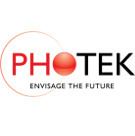 | ||
Founded (September 1, 1991; 25 years ago (1991-09-01)) Key people Gareth Jones(Managing director)Martin Ingle(Technical Director)James Milnes(R&D Manager)Panos Kapetanopoulos(Sales Manager) Products Photomultiplier tubesImaging devicesImaging and analyzing systems Founders Jon Howorth, Geoff Holt, Ralph Powell, Martin Ingle, Mehmet Madakbas | ||
Photek Limited is a specialist manufacturer and global supplier of vacuum based tubes and camera systems for photon detection. Photek manufacture image intensifiers, solar-blind detectors, photomultipliers, streak tubes and a range of associated electronics and camera systems. The company was founded in 1991 by Jon Howorth, Ralph Powell, Martin Ingle, Geoff Holt and Mehmet Madakbas.
Contents
Photek's manufacturing specialty is fast time-resolution devices using micro-channel plates. Fusion plasma diagnostics collaborations with AWE have improved time resolution to less than 100ps for devices with micro-channel plate amplification. Detectors without an MCP, such as vacuum photo-diodes, can go as low as 55ps time resolution. Specialist devices, such as streak tubes, achieve an even better resolution of 1 picosecond or less but must sacrifice one spatial dimension for timing information.
Space Missions
Photek detectors have been used in several space missions through collaborations with academic institutions such as the University of Leicester:
Particle Detectors
Photek are partners in the TORCH project at CERN to produce a new detector for the LHCb upgrade. A concurrent collaboration with Arradiance, USA to develop protective vacuum coatings for electron multipliers has shown ALD-coated photomultipliers can cope with the much higher flux (5C.cm-2) required in particle detector applications.
Velocity Map Imaging
Photek were the first to commercialise Velocity Map Imaging (VMI) technology, offering VMI ion optics and related instrumentation for physical chemistry and laser physics research applications. VMI is a variation of charged-particle imaging that offers high velocity resolution, unlocking information on fundamental chemical structure or the characteristics of the intense, ultra-short laser-particle interaction. VMI was used as a ‘quantum microscope’ to take the first ever ‘photograph’ inside a hydrogen atom in 2013.
